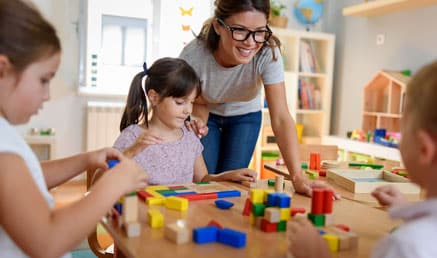
“It’s our polite nudge in the ribs to help you and your team stay organised and on task.”
This week’s subject is: Responsive teaching and scaffolding.
Element 1.2.2: Educators respond to children’s ideas and play and extend children’s learning through open-ended questions, interactions and feedback.
How do you and your team ensure interactions with children and young people are flexible and responsive to their individual needs, and adjust teaching strategies to scaffold children’s learning and foster their confidence in exploring new concepts?
Responsive teaching is achieved when educators recognise and build on children’s existing and developing strengths, skills, and knowledge to support their well-being, motivation, and engagement in learning. Educators observe children’s learning and use their knowledge of individual children, their strengths and abilities to determine when to intervene and when to take a step back, allowing children to explore and apply their learning between different contexts.
Scaffolding is not just about guiding a child to complete a task, it’s also about supporting them to build the skills and confidence they need to independently tackle similar and increasingly challenging tasks in the future, supporting children to become confident and involved learners.
Reflect with your team on the responsive teaching practices educators implement to scaffold children’s learning:
-
- Responding to and extending on children’s ideas and implementing them into the educational program
- Responding to children’s displays of learning dispositions by commenting on them and providing encouragement and additional ideas
- Discussions with children about their learning, exercising open ended questioning to gain ideas for the educational program
- Identifying and utilizing “teachable moments” to extend children’s learning, in both planned and spontaneous contexts
- Encouraging children to, and providing opportunities for them to explore and extend on their interests and stimulate their thinking
- Planning and implementing experiences that support peer scaffolding and extending their learning through engagement with other children
- Providing children with opportunities to extend their learning across different contexts
- Being aware of, and responding to, strategies used by children with additional needs to negotiate their everyday lives.
Resources:
Learning to Learn: Positive dispositions as a “learning curriculum”
Within System7 go to Quality Area 1/Module 5 to submit self-assessment notes and if required, open a QIP issue if you identify any areas of improvement.
The Childcare Centre Desktop has a range of resources to assist services with educational program and practice. These include Educational Program Policy, Educational Program and Practice Procedure, Program Template, Assessment of Learning Summary, Assessment and Planning Cycle Audit, Observation Record and much more.
Resources, NQS Element, Regulation and System7 links:
Childcare Centre Desktop – Childcare Centre Desktop
National Quality Standard – QA 1/ 1.2.2- Responsive teaching and scaffolding
National Regulations – 73, 74, 155, 156
System7 Module – QA 1/ Module 5
If you have any questions send us a note via the Contact page here!




